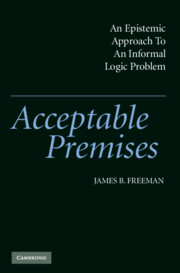Book contents
- Frontmatter
- Contents
- Preface
- Acknowledgments
- PART 1 ACCEPTABILITY: DIALECTICAL AND EPISTEMOLOGICAL COSIDERATIONS
- PART 2 STATEMENTS, BELIEF-GENERATING MECHANISMS, AND PRESUMPTIVE RELIABILITY
- 5 What Types of Statements Are There?
- 6 Necessary Statements and A Priori Intuition
- 7 Descriptions and Their Belief-Generating Mechanisms
- 8 Interpretations and Their Modes of Intuition
- 9 Evaluations and the Moral Faculties
- 10 Taking One's Word: The Interpersonal Belief-Generating Mechanism
- PART 3 PRACTICE AND PERSPECTIVE
- Notes
- References
- Index
8 - Interpretations and Their Modes of Intuition
Published online by Cambridge University Press: 02 December 2009
- Frontmatter
- Contents
- Preface
- Acknowledgments
- PART 1 ACCEPTABILITY: DIALECTICAL AND EPISTEMOLOGICAL COSIDERATIONS
- PART 2 STATEMENTS, BELIEF-GENERATING MECHANISMS, AND PRESUMPTIVE RELIABILITY
- 5 What Types of Statements Are There?
- 6 Necessary Statements and A Priori Intuition
- 7 Descriptions and Their Belief-Generating Mechanisms
- 8 Interpretations and Their Modes of Intuition
- 9 Evaluations and the Moral Faculties
- 10 Taking One's Word: The Interpersonal Belief-Generating Mechanism
- PART 3 PRACTICE AND PERSPECTIVE
- Notes
- References
- Index
Summary
In Chapter 5, we characterized interpretations as contingent nonevaluative intensional statements and developed their connection with explanations. An interpretation typically seeks to render events or conditions meaningful. This is done by somehow relating events nomically or indicating how some event or some condition is to be explained and thus related nomically to certain explanatory factors. In this chapter, we are attempting to determine, first, whether any interpretations are basic beliefs and, second, whether there is a presumption of reliability for the mechanism or mechanisms generating those basic interpretive beliefs. The connection between interpretations and explanations yields a strategy for proceeding. First, what sorts of explanations are presupposed by interpretations? Second, is there some core concept common to these explanations in terms of which the various types of interpretations can be explicated? Assuming this second question can be answered positively – and we shall argue that it can – we may then properly inquire about what mechanisms generate basic beliefs involving this core concept.
THREE TYPES OF EXPLANATIONS
As in Chapter 7 we distinguished physical, personal, and institutional perception, and correspondingly physical, personal, and institutional facts, so we may distinguish physical, personal, and institutional explanations. Physical explanations are a subclass of causal explanations. Some event or phenomenon in the physical world is explained in terms of some antecedent physical event or phenomenon and a covering generalization.
The match lit because it was struck.
This explanation explicitly appeals to the antecedent striking of the match to explain its lighting.
- Type
- Chapter
- Information
- Acceptable PremisesAn Epistemic Approach to an Informal Logic Problem, pp. 143 - 217Publisher: Cambridge University PressPrint publication year: 2004



